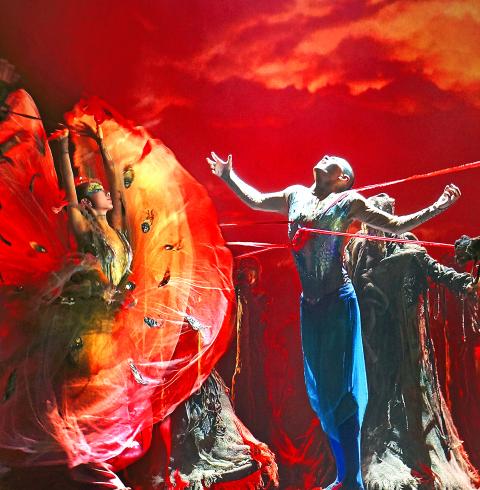Famed dancer Yang Liping (楊麗萍) and her Yunnan Yang Liping Dance Company (雲南楊麗萍文化傳播有限公司) is bringing her 2012 “dance drama” The Peacock (孔雀) to the National Theater in Taipei next week, with all its technicolor glory.
Yang, 57, is a member of the Bai ethnic minority in Yunnan Province, for whom the peacock is a major totem, much like the dragon and phoenix are for Han Chinese, and the bird — which she has come to embody — has been crucial to her career.
Born in Dali, the eldest of four children in a farming family, Yang has said that singing and dancing were a big part of village life. She told the New York Times in a 2005 interview that her grandmother was the best singer in the village.

Photo courtesy of Kuang Hong Arts Management
Her family moved from Dali to Xishuangbanna in southern Yunnan, where at age 11 she was chosen to join the Yunnan Xishuangbanna Song and Dance Troupe, even though she had little formal dance training.
It was then that she fell in love with a dance that imitates the movements of the peacock. By age 21, she had gained fame as the lead dancer in the company’s 1979 production Princess Peacock (雀之戀).
Two years later, she was asked to join the China Central Ethnic Song and Dance Ensemble and she moved to Beijing.
However, whether as a soloist or a lead dancer, Yang reportedly stood out from her colleagues and by the early 1980s, she had decided to try for a solo career.
That decision paid off when a 20-minute piece entitled Spirit of the Peacock (孔雀之魂) won first prize in a national dance competition in 1986, bring her nationwide fame.
The incredibly dexterous movements of her long arms and fingers — capped by long white fingernails — mimic the darting head and neck of the bird and make the fluttering of ballerinas’ arms in Swan Lake look almost clumsy in comparison.
Yang has been quoted as saying that when her two-hour-long The Peacock opened in 2012, it was the culmination of her four-decade-long career.
In The Peacock, Yang tells the story of a young peacock as she grows, falls in love, suffers tragic loss when her beloved sacrifices himself to save her, ages and finally dies. Changing seasons are used to symbolize life’s journey.
The costumes for the show, which look amazing in the publicity photographs, are by Oscar winner Tim Yip (葉錦添).
Yang has become a major cultural industry in China. Her Kunming-based dance troupe, which has two casts employing scores of performers, specializes in the song-and-dance productions that are such a societal staple in China, with a focus on ethnic minority music, dances and traditions.
The company has three programs in its repertoire — 2003’s Shangrila-Dynamic Yunnan (雲南映像), Echoes of Shangrila (雲南的響聲), which premiered in 2009, and The Peacock, with one cast staying at home in Kunming, giving daily performances of the first show, while the touring company performs all three around China and internationally.

June 9 to June 15 A photo of two men riding trendy high-wheel Penny-Farthing bicycles past a Qing Dynasty gate aptly captures the essence of Taipei in 1897 — a newly colonized city on the cusp of great change. The Japanese began making significant modifications to the cityscape in 1899, tearing down Qing-era structures, widening boulevards and installing Western-style infrastructure and buildings. The photographer, Minosuke Imamura, only spent a year in Taiwan as a cartographer for the governor-general’s office, but he left behind a treasure trove of 130 images showing life at the onset of Japanese rule, spanning July 1897 to

In an interview posted online by United Daily News (UDN) on May 26, current Chinese Nationalist Party (KMT) Chairman Eric Chu (朱立倫) was asked about Taichung Mayor Lu Shiow-yen (盧秀燕) replacing him as party chair. Though not yet officially running, by the customs of Taiwan politics, Lu has been signalling she is both running for party chair and to be the party’s 2028 presidential candidate. She told an international media outlet that she was considering a run. She also gave a speech in Keelung on national priorities and foreign affairs. For details, see the May 23 edition of this column,

One of the most important gripes that Taiwanese have about the Democratic Progressive Party (DPP) is that it has failed to deliver concretely on higher wages, housing prices and other bread-and-butter issues. The parallel complaint is that the DPP cares only about glamor issues, such as removing markers of Chinese Nationalist Party (KMT) colonialism by renaming them, or what the KMT codes as “de-Sinification.” Once again, as a critical election looms, the DPP is presenting evidence for that charge. The KMT was quick to jump on the recent proposal of the Ministry of the Interior (MOI) to rename roads that symbolize

Jade Mountain (玉山) — Taiwan’s highest peak — is the ultimate goal for those attempting a through-hike of the Mountains to Sea National Greenway (山海圳國家綠道), and that’s precisely where we’re headed in this final installment of a quartet of articles covering the Greenway. Picking up the trail at the Tsou tribal villages of Dabang and Tefuye, it’s worth stocking up on provisions before setting off, since — aside from the scant offerings available on the mountain’s Dongpu Lodge (東埔山莊) and Paiyun Lodge’s (排雲山莊) meal service — there’s nowhere to get food from here on out. TEFUYE HISTORIC TRAIL The journey recommences with